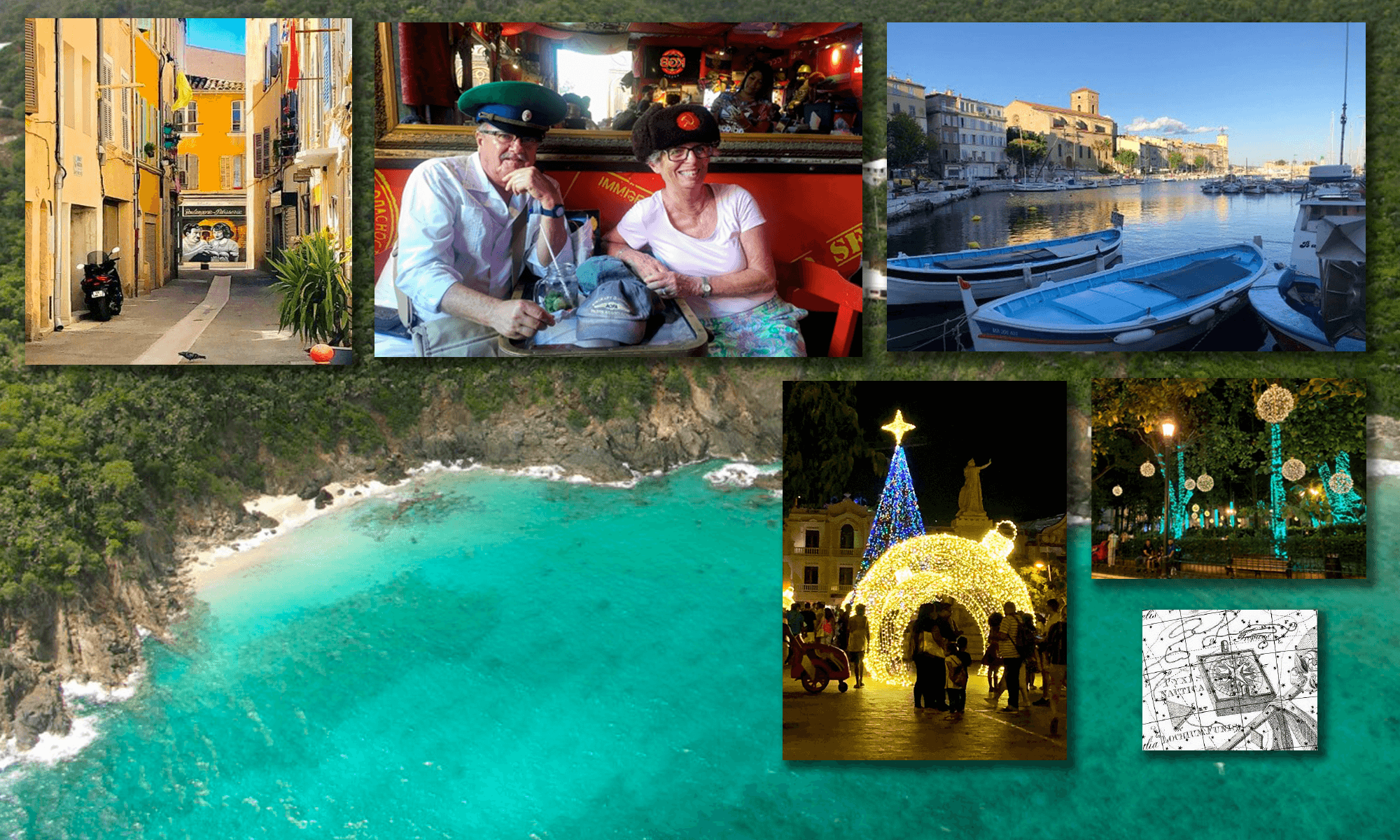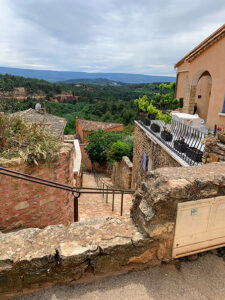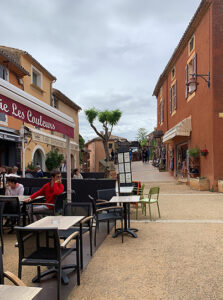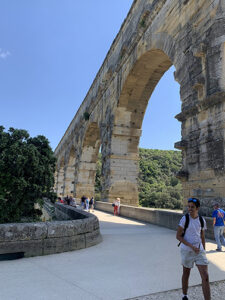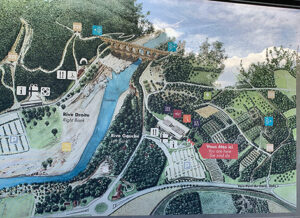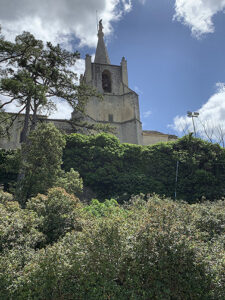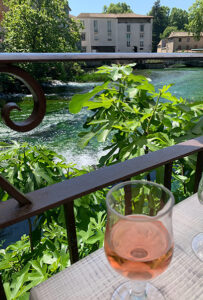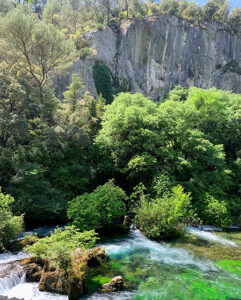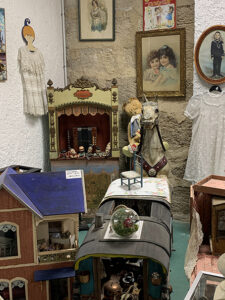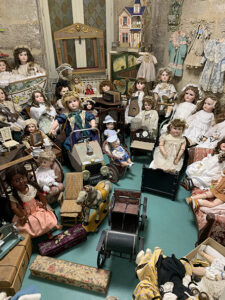L’ISLE SUR LA SORGUE AND NEARBY VILLAGES
It’s time to take the train to L‘Isle sur la Sorge, but before going to the train station we walked to the harbor and watched the fishermen who have just arrived setting up and selling their catch of the day. This is the best way to get fresh seafood for your table at home.
It is nice to be in our own apartment and to go around seeing people we met last year. Our friend Tracy drove her car down from her home in Brittany (12.5 hours) for a visit with plans for us to venture out and visit the nearby villages. Roussillon is one of many “Most Beautiful Villages” especially known for the Ochre, a yellow to red soil which was used for dyeing fabrics and seen in the walls of the buildings. This town is quite colorful and home to many artists and their galleries. As you ascend the winding roads enjoy the panoramic views and the colors of the village. You can even see the white capped Mont Ventoux in the far distance. There are also restaurants having panoramic views while enjoying delightful lunches.
That afternoon we visited Goult another village perched on a hill. This village also has winding streets and tree lined squares surrounded by cafés. We didn’t have time to visit the churches, but we will return to this village another time. We drove up a very narrow street to the Jerusalem Moulin (Mill) and photographed the surrounding areas with again awesome panoramic views. Driving back to L’Isle sur la Sorgue we passed bright red-orange fields of poppies and purple irises growing alongside the roads. It was a beautiful Provence springtime day!
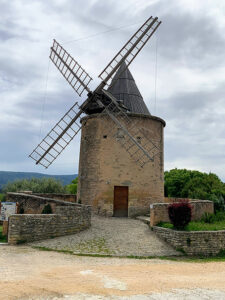 Our next journey was passing around Avignon towards Nimes and Uzes. We were on our way to visit the Pont du Gard Aqueduct. This aqueduct has been listed as a UNESCO SITE. The aqueduct was originally built in the first century to overcome the obstacle of the flooding of the Gardon River in order to bring water from the Uzes to Nimes, a Roman colony. We visited the museum nearby which traces the construction by using artifacts, exhibitions, and films. There is also a restaurant attached. Walking towards the aqueduct we passed a thousand-year-old tree, still thriving! It is the highest known aqueduct in the Roman world. Standing on it you realize the marvel of the construction. There are three levels with 6 arches on the first, 11 arches o the second level and on top there are 35 arches. It has been written that it is the most visited ancient monument in France. We were glad we visited.
Our next journey was passing around Avignon towards Nimes and Uzes. We were on our way to visit the Pont du Gard Aqueduct. This aqueduct has been listed as a UNESCO SITE. The aqueduct was originally built in the first century to overcome the obstacle of the flooding of the Gardon River in order to bring water from the Uzes to Nimes, a Roman colony. We visited the museum nearby which traces the construction by using artifacts, exhibitions, and films. There is also a restaurant attached. Walking towards the aqueduct we passed a thousand-year-old tree, still thriving! It is the highest known aqueduct in the Roman world. Standing on it you realize the marvel of the construction. There are three levels with 6 arches on the first, 11 arches o the second level and on top there are 35 arches. It has been written that it is the most visited ancient monument in France. We were glad we visited.
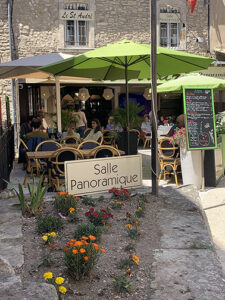 Our next day’s journey was in search of the Abbaye de St. Hilaire, so we followed directions towards La Coste. Ending up on a rutted dirt road that seemed to be a dead end we turned around and decided to visit Bonnieux instead, another one of the “Most Beautiful Villages in France”. Bonnieux is an impressive hilltop village. We walked up winding roads and up old stone stairways until we came upon a lovely restaurant, Le St. Andre. We were just in time for a leisurely lunch. With our energy replenished we walked up further to the old town, passing some beautiful homes. The old church “Vielle Eglise” is at the top. From there we photographed the panoramic vistas of La Coste, Mont Ventoux and the surrounding vineyards. It was worth the climb. Returning down the cobbled road we saw a wine store named Le Wine Club displaying in the window a bottle of a white Chateauneuf-du-Pape. Seeing that beckoned us to rest inside with a lovely glass of this fabulous wine.
Our next day’s journey was in search of the Abbaye de St. Hilaire, so we followed directions towards La Coste. Ending up on a rutted dirt road that seemed to be a dead end we turned around and decided to visit Bonnieux instead, another one of the “Most Beautiful Villages in France”. Bonnieux is an impressive hilltop village. We walked up winding roads and up old stone stairways until we came upon a lovely restaurant, Le St. Andre. We were just in time for a leisurely lunch. With our energy replenished we walked up further to the old town, passing some beautiful homes. The old church “Vielle Eglise” is at the top. From there we photographed the panoramic vistas of La Coste, Mont Ventoux and the surrounding vineyards. It was worth the climb. Returning down the cobbled road we saw a wine store named Le Wine Club displaying in the window a bottle of a white Chateauneuf-du-Pape. Seeing that beckoned us to rest inside with a lovely glass of this fabulous wine.
Ménerbes became the next day’s destination. This is another one of the “Most Beautiful Villages in France”. Ménerbes has attracted many artists and writers. Peter Mayle lived here and after he wrote “A Year in Provence” the village attracted many visitors. Ménerbes is also perched on a hilltop with commanding views. Being later in the afternoon there were few people around. We strolled the roads of this charming village admiring the beautiful homes, the old ancient walls of protection and the picturesque scenes below the ramparts. Leaving we noticed another sign for the Abbaye and decided to return another time for that visit.
We have been curious to find the source of the Sorgue River that encircles L’Isle Sur la Sorgue and the canals throughout our island. So, we drove to Fontaine-de-Vaucluse. Vaucluse is translated from the Latin phrase Vallis Clausa which means closed valley. The source is the largest spring in France. Jacques Cousteau dove it down to 80 meters in 1957. There were other attempts to reach the bottom and finally in 1985 a robot reached the depth of 308 meters. After passing under an aqueduct we arrived in time for lunch, as usual, and enjoyed another delicious meal at Fontaine des Glaces situated on the river. Then we had the energy to walk toward the spring. On the way we were hoping to stop into Le Musée d’Histoire, a museum dedicated to World II and telling the story of what life was like in Vaucluse during the occupation and the activity of the Resistance here. Unfortunately, it was closed. We kept walking along observing the river streaming over the rocks to our right. When we reached the end Frank climbed down for a clearer view. On the way back we visited the Paper Mill and were shown how paper used to be manufactured in Vaucluse. At one time there were 7 paper mills here all powered by water wheels. We continued back to the center of the village enjoying the tranquility. Near to the Saint-Marie-Saint-Véran Church we noticed a statue of Saint Veranus. Legend has it that he defeated the dragon that terrified the people by wrapping it in chains and dragging it away. We are looking forward to return to visit the museum of the Resistance and another museum called Le Musée Du Monde Souterrain. This museum exhibits the abysm, the underground river and cave paintings. This ended our wonderful adventures with Tracy.
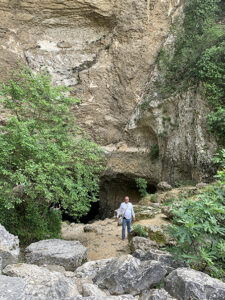 We enjoyed our few weeks staying in our apartment and going out each day to discover more of our island. Last time while we were here we didn’t visit any museums so that was on our list. We visited Musée du Jouet et de la Poupée Ancienne, a museum of Antique Toys and Dolls dating from 1880-1920. It is a private collection created by Madame Huguette Jeanselme. Some were even animated when wound up such as the carousel. We are saving the Compredon Centre d’Art for next year now that we have found its location. There are also a lot of music events that take place there. We had been introduced to a couple who have an apartment across the road. We also connected with friends we met last time. Another day we walked up to Musee La Filaventure – Brun de Vian-Tiran. This is a specialty museum showing the history of the weaving industry, especially the Brun de Vian-Tiran brand products. There is a store in front with these beautiful woolen products.
We enjoyed our few weeks staying in our apartment and going out each day to discover more of our island. Last time while we were here we didn’t visit any museums so that was on our list. We visited Musée du Jouet et de la Poupée Ancienne, a museum of Antique Toys and Dolls dating from 1880-1920. It is a private collection created by Madame Huguette Jeanselme. Some were even animated when wound up such as the carousel. We are saving the Compredon Centre d’Art for next year now that we have found its location. There are also a lot of music events that take place there. We had been introduced to a couple who have an apartment across the road. We also connected with friends we met last time. Another day we walked up to Musee La Filaventure – Brun de Vian-Tiran. This is a specialty museum showing the history of the weaving industry, especially the Brun de Vian-Tiran brand products. There is a store in front with these beautiful woolen products.
To discover L’Isle sur Sorge from a different perspective we took La Petit Train. During the 35–40-minute tour through the streets we learned about the cultural and industrial heritage of this village. Halfway, the train stopped at a beautiful area at the end of le Partage des eaux to enjoy the scenery. We had previously walked up this passage watching children during a kayak lesson, but only went partway and were glad we finally reached the end to see the restaurant Le Pescador and the park on the river.
